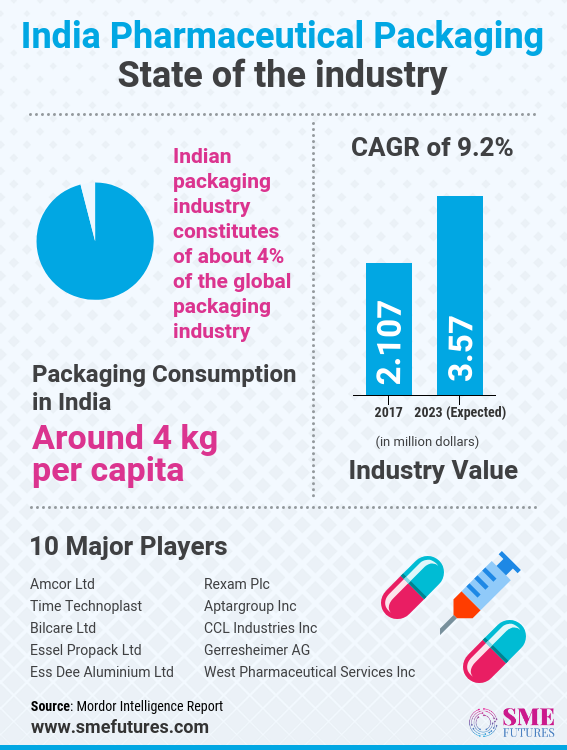Rapid rise in population and increasing access of medicines is driving the demand for advanced pharmaceutical packaging products. With the constantly evolving manufacturing practices, the heavily regulated pharma manufacturers are adopting new methods in terms of drug development, sustainable packaging, promotion etc. However, since environmental sustainability has become a key issue across sectors globally, there is tremendous pressure on the manufacturers to act on that front.
In a conversation with SME Futures, AVPS Chakravarthi, global ambassador, World Packaging Organisation – a non-profit international federation for global packaging community, discusses the current state of the pharma packaging in India, the challenges, and where the sector is headed.
Edited Excerpts:
What’s your views on the Indian pharmaceutical packaging industry in India?
Pharmaceutical packaging is an important segment in the India’s overall packaging industry. It’s a huge industry putting together different stakeholders, including raw material, additives, allied industries, service providers, machinery etc. Also, I am not wrong if I say that the growth of Indian pharmaceuticals packaging industry is directly linked to growth of pharmaceutical manufacturing industry. As per the research platform Mordor Intelligence, the India pharmaceutical packaging, which was a US$ 2.107 billion market in 2017, is expected to reach US$ 3.57 billion by the end of 2023. Moreover, the sector is getting additional spur as the purchasing power of citizens in terms of healthcare services, especially medicines, has increased.
There is a surge in demand and export of pharmaceuticals from India which is also influencing the market growth. With this, pharmaceutical manufacturers are embracing new trends and effective practices on the packaging front. Currently, India produces a large quantity of plastic pharmaceutical packaging at the global level. There are large multinational pharma packaging companies such as Amcor, Huhtamaki, West Pharma and SGD Pharma, along with Indian firms, including UFlex and Essel Propack – leading the way of the pharma packaging market. However, there are more MSMEs running the sector.
What are the major challenges the pharma packaging sector is facing?
Pharmaceutical packaging and labelling are not so easy. There are many challenges that pharma companies face when it comes to packaging and labelling of the drugs. First and foremost, rules and regulations of packaging compliance vary across different regions. Generally, a pharmaceutical company sells the same product under different names. As companies produce those drugs on a single process line, the task of printing, labelling, and packaging can be cumbersome. For instance: the US and the UK have altogether different pharmaceutical packaging legal requirements, and to export a drug composition you have to satisfy both of them.
Giving priority to the patient safety, regulations are updated regularly, thus it’s difficult to comply with evolving packaging regulations. In addition, pharma companies – in order to fulfill their own business goals – have to satisfy regulatory guidelines for maintaining their brand.
Another challenge is label space availability. It is mandatory to fulfill the regulatory requirements for marketing and branding. Also, manufacturers have to print all the information regarding medicine to give proper dosage information and drug composition. Moreover, additional language translations, expiry date, serial numbers and parameters such as minimum age and side effects are also needed to be printed for safer consumption, which can be a daunting task.

Misprinting and packaging error can be fatal. If a person takes wrong dosage due to misprints, it can have severe impact on health; and it can also tarnish the reputation of pharma companies, leading to loss of revenues. For instance: In initial months of 2019, an international brand had to recall packs of birth control pills due to packaging errors. The pills were out of sequence due to which patients were consuming placebo instead of an active tablet – which was resulting in loss of efficacy in the dosage consumed. Though there was no case of adverse effect reported, still the pharma company had to recall the packs and revenue was lost.
Pharma packaging usually relies upon plastic packaging. However, environmental sustainability has become the talk of the town in every sector. How this industry is viewing this?
It’s true that pharma packaging heavily relies on plastic packaging. Considering the environmental issues, today it has become one of the pharmaceutical-related issues. This has triggered discussions on recycling and sustainable packaging in the sector. Using environmental-friendly designs and sustainable material for packaging is the goal. Having said that, this is another challenge as the sector is dependent on compliance issues, safety regulations, child resistant packaging, elderly ease packaging, dose control issues, countering fake etc.
Another aspect of packaging is that manufacturers have to safeguard the efficacy of the product till the date of expiry, and there is no compromise on it. For this, there are multiple layers of product, comprising of high-barrier properties such as combinations of aluminium and various resins. The question arises how to manage sustainability measures in packaging along with product efficacy. Keeping all these aspects in mind, pharma companies require advanced packaging solutions which can yield 100 per cent recyclable packaging.
As far as I know, the sector is investing heavily on this front and is researching on ‘monomer’ which is 100 per cent recyclable, and I hope this will be a reality in coming years. It’s not just that research institutes are working on finding sustainable and recyclable material for packaging, but some companies are also facilitating the testing. Sustainable packaging in pharma sector has numerous opportunities, and the use of sustainable materials can help in building brand positioning and reputation too. However, in my opinion we have to go a long way to invent real biodegradable material for packaging.
What are the opportunities for MSMEs in the pharmaceutical packaging sector?
It’s a huge challenge for MSMEs, irrespective of any vertical, in terms of capital investment and regulatory compliance. Pharmaceutical packaging requires huge investments to fund packaging machines and operations. For instance: For a six colour offset printing machine with an online portal, a business needs to invest at least ₹10-₹12 crore just for a machine, and there are additional operational costs. Similarly, temperature-controlled packaging also requires huge investment. This shifts manufacturers to prefer rented and reusable packaging.
Despite this, I strongly advocate there is no big barrier to enter this sector. On the contrary, there are allied segments into which small businesses can venture such as repackaging and relabelling of healthcare products, OTC products, products promotion etc., with investments of ₹10-₹15 lakh; or can be service providers. So, it is just that there are immense opportunities that one can explore.

How do you foresee the future of pharma packaging industry in India?
India being the pharmacy of the world, drug manufacturing has evolved. With this, I foresee the bright future of pharmaceutical packaging. Like any other packaged goods, pharmaceuticals need reliable and speedy packaging solutions that offer product protection, quality, tamper evidence, patient comfort and security needs. Also, India’s pharmaceutical packaging experts are innovating constantly, creating features like digital timers and alarms on pill bottles, dose monitoring and innovative mechanized blister packs. New packaging is helpful in curbing counterfeit issues and employing different security techniques. On the other hand, in the present economic sentiments, pharma is the only sector that recorded double digit growth in the past fiscal. When everything else either saw negative growth or low-growth percentage, pharma recorded growth in terms of exports and domestic operations too. This in turn replicate the growth in pharma packaging sector also. So, in my opinion this sector is only going to improve in the long run.











